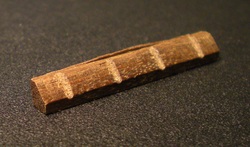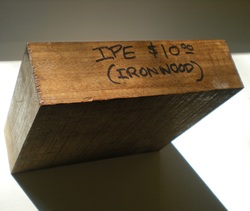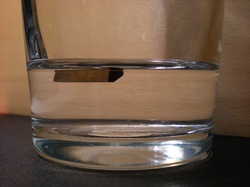[Adan] Okay, here's the answer: that's a little piece of ipe, the wood also known as ironwood. It's the nut from one of our beta model baritone ukuleles, or will be after it sees a little more work.
In this paragraph I intended to write some interesting factoids about ipe, a.k.a. ironwood. The only trouble is that
Wikipedia has just informed me that "ironwood" is an overused name that may or may not describe about twenty different woods: "
Ironwood is a common name for a large number of woods that have a reputation for hardness. Usage of the name may (or may not) include the tree that yields this wood."The image above shows the block from which we made this nut, and the labeling that caused us to believe that "ipe" is "Ironwood." One of the things I was told upon buying this (quite heavy) block was that "ironwood will sink in water, you know." So I was eager to mention that in this article... but now I'm filled with doubt. Science to the rescue:
Well! Okay then... Let's make some measurements. Block dimensions are 17x16x4.7cm = 1278cm^3. Block mass is 1225g. Aha! Density is 0.96g/cm^3, which is why that nut was not interested in being a sinker demonstrator. It wasn't floating very high... but it sure wasn't sinking.
Time to abandon Wikipedia and seek a more obscure but perhaps more focussed reference: How about the
ipe page on the WoodsTheBest site? Looks good to me. Here they confirm: density should be in the range of 0.85-0.97, so our block is actually on the high end.
We chose this wood for two reasons: importantly, of course, its contrasting color, dark to beech's medium-light. Even more importantly, though, is the tonal effect. We hoped the higher density would correspond with a more efficient energy transfer, and in fact this seems to be the case. These little pieces, the nuts and saddles and tailbars, make a ceramic-like clinking noise when you bounce a few around in your hand. And the proof's in the pudding: the instrument does sound very nice!
This block that we have should, if used efficiently, be able to make a large supply of such attractive and functional instrument components.


